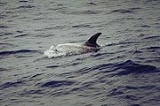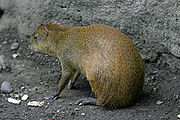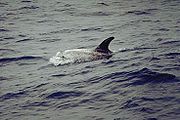
List of mammals in the Cayman Islands
Encyclopedia
This is a list of the mammal species recorded in the Cayman Islands. There are 10 mammal species in the Cayman Islands
, of which none are believed to be threatened.
The following tags are used to highlight each species' conservation status as assessed by the IUCN
:
Some species were assessed using an earlier set of criteria. Species assessed using this system have the following instead of Near Threatened and Least Concern categories:
The bats' most distinguishing feature is that their forelimbs are developed as wings, making them the only mammals in the world naturally capable of flight. Bat species account for about 20% of all mammals.
 Rodentia is an order
Rodentia is an order
of mammal
s characterised by two continuously growing incisors in the upper and lower jaws which must be kept short by gnawing. Forty percent of mammal species are rodents, and they are found in vast numbers on all continents other than Antarctica. Rodents have sharp incisors that they use to gnaw wood, break into food, and bite predators. Most eat seeds or plants, though some have more varied diets. Some species have historically been pests, eating seeds stored by people and spreading disease.
The name comes from the Latin
word rodens, "gnawing one" (from the verb rodere, "gnaw").
In terms of number of species
—although not necessarily in terms of number of organisms (population) or biomass
—rodents make up the largest order of mammals. There are about 2,277 species
of rodents (Wilson and Reeder, 2005), with over 40 percent of mammalian species belonging to the order.
The Central American Agouti
have been introduced to the Cayman Islands, and are found in forests, thick brush, savannas, and cultivated areas.
Order: Cetacea
----
 The order Cetacea includes whale
The order Cetacea includes whale
s, dolphin
s and porpoise
s. They are the mammals most fully adapted to aquatic
life with a spindle-shaped nearly hairless body, protected by a thick layer of blubber, and forelimbs and tail modified to provide propulsion underwater.
Cayman Islands
The Cayman Islands is a British Overseas Territory and overseas territory of the European Union located in the western Caribbean Sea. The territory comprises the three islands of Grand Cayman, Cayman Brac, and Little Cayman, located south of Cuba and northwest of Jamaica...
, of which none are believed to be threatened.
The following tags are used to highlight each species' conservation status as assessed by the IUCN
World Conservation Union
The International Union for Conservation of Nature and Natural Resources is an international organization dedicated to finding "pragmatic solutions to our most pressing environment and development challenges." The organization publishes the IUCN Red List, compiling information from a network of...
:
| EX | Extinct | No reasonable doubt that the last individual has died. |
| EW | Extinct in the wild | Known only to survive in captivity or as a naturalized populations well outside its previous range. |
| CR | Critically Endangered | The species is in imminent risk of extinction in the wild. |
| EN | Endangered | The species is facing an extremely high risk of extinction in the wild. |
| VU | Vulnerable | The species is facing a high risk of extinction in the wild. |
| NT | Near Threatened | The species does not meet any of the criteria that would categorise it as risking extinction but it is likely to do so in the future. |
| LC | Least Concern | There are no current identifiable risks to the species. |
| DD | Data Deficient | There is inadequate information to make an assessment of the risks to this species. |
Some species were assessed using an earlier set of criteria. Species assessed using this system have the following instead of Near Threatened and Least Concern categories:
| LR/cd | Lower Risk/conservation dependent | Species which were the focus of conservation programmes and may have moved into a higher risk category if that programme was discontinued. |
| LR/nt | Lower Risk/near threatened | Species which are close to being classified as Vulnerable but are not the subject of conservation programmes. |
| LR/lc | Lower Risk/least concern | Species for which there are no identifiable risks. |
Order: Chiroptera (bats)
----The bats' most distinguishing feature is that their forelimbs are developed as wings, making them the only mammals in the world naturally capable of flight. Bat species account for about 20% of all mammals.
-
- Family: Molossidae
- Genus: TadaridaTadaridaThe genus Tadarida has ten or more species of bats divided into two subgenera, with the first of these containing seven species spread across the Old World...
- Mexican Free-tailed BatMexican Free-tailed BatThe Mexican free-tailed bat , also known as the Brazilian free-tailed bat, is a medium-sized bat that is native to the Americas and is widely regarded as one of the most abundant mammals in North America...
Tadarida brasiliensis LR/nt
- Mexican Free-tailed Bat
- Genus: Tadarida
- Family: Phyllostomidae
- Subfamily: PhyllostominaePhyllostominaePhyllostominae is a subfamily of bats.-List of species:Subfamily Phyllostominae* Tribe Micronycterini**Genus: Glyphonycteris***Behn's Bat, Glyphonycteris behnii***Davies's Big-eared Bat, Glyphonycteris daviesi...
- Genus: MacrotusMacrotusMacrotus is a genus of bats in the Neotropical family Phyllostomidae. This genus contains two species, Macrotus californicus commonly known as California Leaf-nosed Bat and Macrotus waterhousii commonly known as Mexican or Waterhouse's Leaf-nosed Bat...
- Waterhouse's Leaf-nosed BatWaterhouse's Leaf-nosed BatWaterhouse's Leaf-nosed Bat is a species of bat in the family Phyllostomidae. It is found in Bahamas, Cayman Islands, Cuba, the Dominican Republic, Guatemala, Haiti, Jamaica, Mexico, and Puerto Rico.Waterhousii is also a big eared Bat which has ranges from Sonora to Hidalgo Mexico, south to...
Macrotus waterhousii LR/lc
- Waterhouse's Leaf-nosed Bat
- Genus: Macrotus
- Subfamily: Brachyphyllinae
- Genus: BrachyphyllaBrachyphyllaBrachyphylla is a genus of bat in the family Phyllostomidae.It contains the following species:* Cuban Fruit-eating Bat * Antillean Fruit-eating Bat...
- Cuban Fruit-eating BatCuban Fruit-eating BatThe Cuban Fruit-eating Bat is a species of bat in the family Phyllostomidae. It is found in Bahamas, Cayman Islands, Cuba, the Dominican Republic, Haiti, Jamaica, and Turks and Caicos Islands.-Source:...
Brachyphylla nana LR/nt
- Cuban Fruit-eating Bat
- Genus: Brachyphylla
- Subfamily: Phyllonycterinae
- Genus: Erophylla
- Buffy Flower BatBuffy Flower BatThe Buffy Flower Bat is a species of bat in the leaf-nosed bat family, Phyllostomidae. It is monotypic within the genus Erophylla. It is found in the Bahamas, the Cayman Islands, Cuba, and Jamaica.-References:...
Erophylla sezekorni LR/lc
- Buffy Flower Bat
- Genus: Erophylla
- Subfamily: StenodermatinaeStenodermatinaeStenodermatinae is a large subfamily of bats in the family Phyllostomidae.-List of species:Subfamily Stenodermatinae*Genus: Ametrida**Little White-shouldered Bat, Ametrida centurio*Genus: Ardops**Tree Bat, Ardops nichollsi...
- Genus: ArtibeusArtibeusThe Neotropical fruit bats are a genus of bats within the subfamily Stenodermatinae. The genus consists of 21 species, which are native to Central and South America, as well as parts of the Caribbean.-Description:...
- Jamaican fruit batJamaican fruit batThe Jamaican, Common or Mexican fruit bat is a fruit bat native to Central and South America, as well as the Greater and many of the Lesser Antilles. It is also an uncommon resident of the Southern Bahamas...
Artibeus jamaicensis LR/lc
- Jamaican fruit bat
- Genus: Phyllops
- Cuban Fig-eating BatCuban Fig-eating BatThe Cuban Fig-eating Bat is a species of bat in the family Phyllostomidae, and the only species in the genus Phyllops. It is found in Cayman Islands, Cuba, the Dominican Republic, and Haiti.-Source:...
Phyllops falcatus LR/nt
- Cuban Fig-eating Bat
- Genus: Artibeus
- Subfamily: Phyllostominae
- Family: Molossidae
Order: Rodentia (Rodents)
----
Order (biology)
In scientific classification used in biology, the order is# a taxonomic rank used in the classification of organisms. Other well-known ranks are life, domain, kingdom, phylum, class, family, genus, and species, with order fitting in between class and family...
of mammal
Mammal
Mammals are members of a class of air-breathing vertebrate animals characterised by the possession of endothermy, hair, three middle ear bones, and mammary glands functional in mothers with young...
s characterised by two continuously growing incisors in the upper and lower jaws which must be kept short by gnawing. Forty percent of mammal species are rodents, and they are found in vast numbers on all continents other than Antarctica. Rodents have sharp incisors that they use to gnaw wood, break into food, and bite predators. Most eat seeds or plants, though some have more varied diets. Some species have historically been pests, eating seeds stored by people and spreading disease.
The name comes from the Latin
Latin
Latin is an Italic language originally spoken in Latium and Ancient Rome. It, along with most European languages, is a descendant of the ancient Proto-Indo-European language. Although it is considered a dead language, a number of scholars and members of the Christian clergy speak it fluently, and...
word rodens, "gnawing one" (from the verb rodere, "gnaw").
In terms of number of species
Species
In biology, a species is one of the basic units of biological classification and a taxonomic rank. A species is often defined as a group of organisms capable of interbreeding and producing fertile offspring. While in many cases this definition is adequate, more precise or differing measures are...
—although not necessarily in terms of number of organisms (population) or biomass
Biomass (ecology)
Biomass, in ecology, is the mass of living biological organisms in a given area or ecosystem at a given time. Biomass can refer to species biomass, which is the mass of one or more species, or to community biomass, which is the mass of all species in the community. It can include microorganisms,...
—rodents make up the largest order of mammals. There are about 2,277 species
Species
In biology, a species is one of the basic units of biological classification and a taxonomic rank. A species is often defined as a group of organisms capable of interbreeding and producing fertile offspring. While in many cases this definition is adequate, more precise or differing measures are...
of rodents (Wilson and Reeder, 2005), with over 40 percent of mammalian species belonging to the order.
The Central American Agouti
Central American Agouti
The Central American Agouti is an agouti species from the family Dasyproctidae. The species is widespread in Mesoamerica and South America. The northern section of the range occurs from Chiapas and the Yucatan Peninsula to northern Ecuador and Colombia and western Venezuela...
have been introduced to the Cayman Islands, and are found in forests, thick brush, savannas, and cultivated areas.
-
- Family: DasyproctidaeDasyproctidaeDasyproctidae is a family of large South American rodents, comprising the agoutis and acouchis. Their fur is a reddish or dark colour above, with a paler underside. They are herbivorous, often feeding on ripe fruit that falls from trees...
-
-
- Genus: Dasyprocta
- Species: Dasyprocta punctata, Central American AgoutiCentral American AgoutiThe Central American Agouti is an agouti species from the family Dasyproctidae. The species is widespread in Mesoamerica and South America. The northern section of the range occurs from Chiapas and the Yucatan Peninsula to northern Ecuador and Colombia and western Venezuela...
- Species: Dasyprocta punctata, Central American Agouti
- Genus: Dasyprocta
-
-
- Family: Dasyproctidae
Order: CetaceaCetaceaThe order Cetacea includes the marine mammals commonly known as whales, dolphins, and porpoises. Cetus is Latin and is used in biological names to mean "whale"; its original meaning, "large sea animal", was more general. It comes from Ancient Greek , meaning "whale" or "any huge fish or sea...
(whales)
----
Whale
Whale is the common name for various marine mammals of the order Cetacea. The term whale sometimes refers to all cetaceans, but more often it excludes dolphins and porpoises, which belong to suborder Odontoceti . This suborder also includes the sperm whale, killer whale, pilot whale, and beluga...
s, dolphin
Dolphin
Dolphins are marine mammals that are closely related to whales and porpoises. There are almost forty species of dolphin in 17 genera. They vary in size from and , up to and . They are found worldwide, mostly in the shallower seas of the continental shelves, and are carnivores, mostly eating...
s and porpoise
Porpoise
Porpoises are small cetaceans of the family Phocoenidae; they are related to whales and dolphins. They are distinct from dolphins, although the word "porpoise" has been used to refer to any small dolphin, especially by sailors and fishermen...
s. They are the mammals most fully adapted to aquatic
Aquatic adaptation
Several animal groups have undergone aquatic adaptation, going from being purely terrestrial animals to living at least part of the time in water. The adaptations in early speciation tend to develop as the animal ventures into water in order to find available food. As successive generations spend...
life with a spindle-shaped nearly hairless body, protected by a thick layer of blubber, and forelimbs and tail modified to provide propulsion underwater.
- Suborder: Odontoceti
- Superfamily: Platanistoidea
- Family: Ziphidae
- Subfamily: Hyperoodontidae
- Genus: Mesoplodon
- Blainville's Beaked WhaleBlainville's Beaked WhaleBlainville's beaked whale , or the dense-beaked whale, is the widest ranging mesoplodont whale and perhaps the most documented. Henri de Blainville first described the species in 1817 from a small piece of jaw—the heaviest bone he had ever come across—which resulted in the name densirostris...
Mesoplodon densirostris DD
- Blainville's Beaked Whale
- Genus: Mesoplodon
- Subfamily: Hyperoodontidae
- Family: Delphinidae (marine dolphins)
- Genus: StenellaStenellaStenella is a genus of aquatic mammals in Delphinidae, the family informally known as the oceanic dolphins.Currently five species are recognised in this genus:*Pantropical Spotted Dolphin, S. attenuata*Atlantic Spotted Dolphin, S. frontalis...
- Clymene DolphinClymene DolphinThe Clymene dolphin , in older texts known as the Short-snouted spinner dolphin, is a dolphin endemic to the Atlantic Ocean.- Taxonomy :...
Stenella clymene DD
- Clymene Dolphin
- Genus: Lagenodelphis
- Fraser's DolphinFraser's DolphinFraser's Dolphin or Sarawak Dolphin is a cetacean in the family Delphinidae found in deep waters in the Pacific Ocean and to a lesser extent in the Indian and Atlantic Oceans.-Taxonomy:...
Lagenodelphis hosei DD
- Fraser's Dolphin
- Genus: Grampus
- Risso's DolphinRisso's DolphinRisso's dolphin is the only species of dolphin in the genus Grampus.-Taxonomy:Risso's dolphin is named after Antoine Risso, whose description formed the basis of the first public description of the animal, by Georges Cuvier, in 1812...
Grampus griseus DD
- Risso's Dolphin
- Genus: Stenella
- Family: Ziphidae
- Superfamily: Platanistoidea
See also
- List of chordate orders
- List of regional mammals lists
- List of prehistoric mammals
- Mammal classificationMammal classificationMammalia is a class of animal within the Phylum Chordata. Mammal classification has been through several iterations since Carolus Linnaeus initially defined the class. Many earlier ideas have been completely abandoned by modern taxonomists, among these are the idea that bats are related to birds...
- New mammal species

